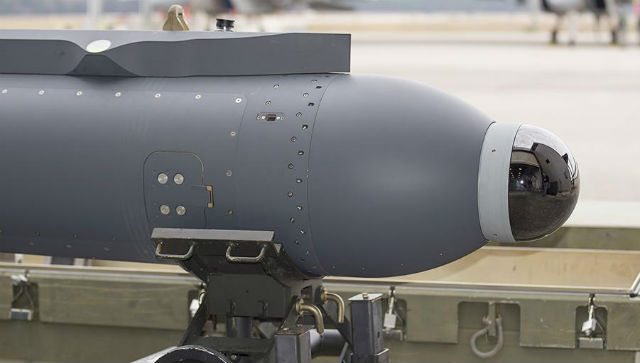Lockheed Martin wants to bring fifth-generation targeting and tracking capabilities to fourth-generation aircraft such as the Boeing F-15 and Lockheed F-16 fighters.
The company debuted its internally developed Legion pod at the US Air Force Association’s 2015 Air Warfare Symposium in Orlando, Florida, where it is being pitched as a retrofit that can provide infrared search and track (IRST) capabilities to legacy aircraft.

Lockheed Martin
The pod would also support collaborative targeting between multiple aircraft in radar-denied environments. The 16in-wide pod is tipped with Lockheed’s IRST21 infrared sensor, which began limited operation aboard US Navy Boeing F/A-18E/F Super Hornets earlier this year. The sensor provides advanced networking and data processing to target and track enemy aircraft.
On the F/A-18E/F the IRST21 sensor is mounted on the nose of the centerline fuel tank. The podded system can be installed on a wide range of aircraft, but Lockheed is aiming it primarily at legacy F-15Cs and the F-16, for which there is a healthy international upgrade market.
The multifunction pod’s baseline configuration includes an advanced processor and datalink in addition to its IRST sensor, allowing it to network equipped fighters so they can share targeting data and other information. Lockheed is marketing the system as an affordable option to upgrade legacy fighters with capabilities that are anticipated in anti-access, aerial-denial environments.
Ken Fuhr, director of fixed-wing programmes at Lockheed’s Missiles and Fire Control division, says the pod is production-ready and can be “quickly procured and integrated to meet current and emerging requirements”.
Flight testing to achieve certification of an F-16 configured with the pod is scheduled for this year, Lockheed says. Additional flights aboard other aircraft are scheduled for 2016. The system already has achieved limited qualification under the company-funded development programme.
As yet there is no requirement for the device, but the US Air Force is working to ensure fifth-generation aircraft such as the Lockheed F-22 and F-35 will be able to communicate with the legacy types they will fly alongside in future conflicts. The F-22 and F-35 will also need modifications in order to share positioning and targeting information, once the newer aircraft becomes operational later this year.
In that context, the Legion pod will be offered for the F-15C IRST programme to upgrade that fighter’s long-range targeting capabilities.
The system will also be a contender for the multi-domain adaptable processing system (MAPS), which is envisioned as a pod to enable communications between stealth fighters. Lockheed also believes the pod could be retrofitted onto other non-fighter aircraft to provide multi-sensor data transmission for platforms such as the Boeing B-1 and Northrop Grumman B-2 bombers.
MAPS is one of several upcoming air force programmes from which officials are willing to stomach capability cuts in the interest of affordability and speed of acquisition. Along with programmes such as the T-X trainer, the requirement will undergo a “cost-capability analysis” to identify reasonable requirement downgrades that can deliver significant cost reduction.
Source: Flight International
















